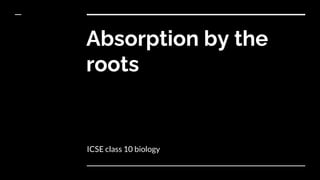
Absorption by the roots
- 1. Absorption by the roots ICSE class 10 biology
- 2. Introduction ● The most important and life supporting function of the roots is to absorb water and minerals from the soil and conduct it to the rest of the parts of the plants like leaves, flowers, fruits, etc.
- 3. Absorption and conduction of minerals ● The movement of water and minerals through the thickness of the root and upward conduction through the stem is the result of 5 main phenomenon. ○ Imbibition ○ Diffusion ○ Osmosis ○ Active transport ○ Turgidity and flaccidity
- 4. Imbibition ● Imbibition is the phenomenon by which the living or dead plant cells absorb water by surface attraction ● Substances made up of cellulose have a strong affinity for water they absorb water and swell up (imbibe) ● For example due to imbibitional pressure seed coat ruptures in case of germinating seeds
- 5. Diffusion ● Diffusion is the free movement of molecules of a substance from the region of higher concentration to the region of lower concentration when 2 are in direct contact .
- 6. osmosis ● It is the movement of water molecules from a region of higher concentration to the region of lower concentration through a semi-permeable membrane ● Osmosis can either be inward or outward. ○ Endosmosis ■ It is the inward diffusion of water through a semi-permeable membrane when surrounding solution is less concentrated. ■ This swells up the cell ○ Exosmosis ■ It is the outward diffusion of water through a semipermeable membrane when surrounding solution is more concentrated. ■ This shrinks the cell
- 7. Osmotic pressure ● Osmotic pressure is equal to the weight or pressure required to nullify osmosis ● Osmotic pressure of a solution is a measure of its tendency to take in water by osmosis ● Tonicity is the relative concentration of the solutions that determine the direction and extent of diffusion ● Tonicity is of 3 types ○ Isotonic ○ Hypotonic ○ hypertonic
- 8. Isotonic, hypotonic, hypertonic ● Isotonic ○ The relative concentration of water molecules and the solute on either side of the cell membrane is same ○ Here there is no net movement of water molecules across the cell membrane ○ No change in shape or size ● Hypotonic (endosmosis) ○ The solution outside the cell has a lower concentration then the fluids inside the cell membrane ○ Here the water molecules from outside will move into the cell. ○ Cell enlarges and even bursts ● Hypertonic (exosmosis) ○ The solution outside the cell has a higher concentration than the fluids inside the cell membrane ○ Here the water molecules from the interior of the cell will move out ○ The cell shrinks
- 9. Active vs passive transport ● Active transport features the transport of a cell from lower concentration to higher concentration through a living cell membrane ● Active transport uses energy from the cell ● Passive transport features free movement of molecules from higher concentration to lower concentration ● Passive transport does not require energy
- 10. Turgidity ● When a cell reaches a stage where it cannot accommodate any more water it is fully swollen it is called turgid and the condition is called turgidity ● The pressure of the cell contents on the cell wall is called turgor pressure and the pressure exerted by the cell wall is called wall pressure ● When the cell is turgid it is in somewhat of a balanced state ○ No more water enters or exits the cell even though the concentration of the cell may be greater than the outside of the cell.
- 11. Plasmolysis and flaccidity ● Plasmolysis ○ It is the contraction of the cytoplasm from the cell wall due to the withdrawal of water when placed in a strong hypertonic solution ● Deplasmolysis ○ The recovery of plasmolysis is called deplasmolysis. ● Flaccidity ○ It is the condition in which the cell content is shrunken and the cell is no more tight. The cell is said to be flaccid.
- 12. Force contributing to the ascent of the sap ● Root pressure ○ Root pressure builds up sufficient force to push the sap in the xylem vessels up to a certain height and may be enough for herbaceous plants ● Capillarity ○ The narrow diameter of the xylem vessels causes the water to rise from a lower level and fill up the vacuum created by the loss of water due to transpiration of the leaves ● Transpiration pull ○ As the water is lost from the leaf surface by transpiration, more water molecules are pulled up due to the tendency of water molecules to remain joined and thus to produce a continuous column of water through the stem. ● Adhesion ○ It causes water to stick to the cells thus drawing more water molecules from below when the leaf cells lose water during transpiration. This pulling force provided by the leaves is important in tall trees.